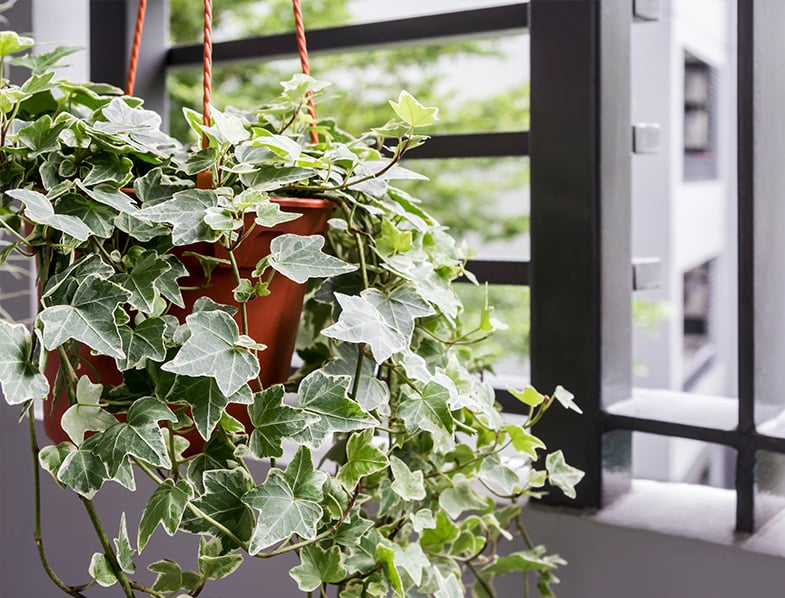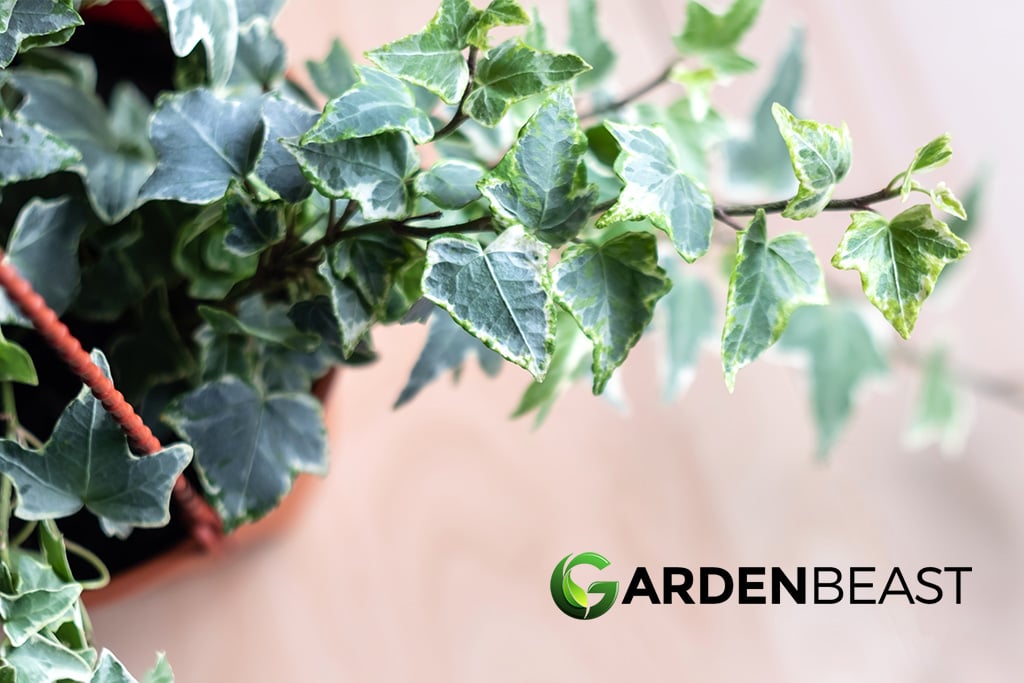Ivy has been found in homes, gardens, and even offices all over the world. Ivy plants are a great source of greenery that is very low maintenance when compared with other options.
The English Ivy, in particular, is a common choice among homeowners and office managers alike. The names of the ivy variety give a suggestion about its appearance. For example, Curlilocks English ivy will feature waved leaves while the Gold Child variety will have splashes of white and gold on the leaves.
The lush green leaves of this tropical plant make it the perfect choice for those looking for an elegant accent for any room. The leaves are small which allows it to blend into smaller potted gardens while adding texture to the space. Indoors, the English Ivy Plant is most often used as a hanging plant, but can also be house in a floor or table pot.
More experienced or patient plant owners can teach their Hedera helix to grow over a standing topiary for a customized green landscape. The plant is fast-growing and thrives when given plenty of light and water.
Although it grows quickly, it will only need to be reported every other year. This makes it an easy to care for plant for those who may be limited on time and space.
With so many varieties to choose from, it is easy to find a plant that has leaf colors to match your aesthetic.
Watch Our Latest YouTube Video ...
About the English Ivy
- English ivy grows quickly in the sun and with proper moisture.
- There are several hundred types of English ivy all with different color leaves.
- The Hedera helix is a tropical plant and will grow best in humid climates but can live in cooler climates with proper care.
- Plants should not be housed near vents or fans to prevent dehydration.
- They are commonly attacked by spider mites, but no other pests.
- Pruning can be done all year long to help maintain a specific shape or size.
- Variegated ivy plants that sprout all green leaves should be pruned.
- The Hedera helix may cause minor skin irritation.

English Ivy Features: An Overview
- The botanical name of the English Ivy Plant is Hedera helix.
- The plant produces notable trailing vines and lobed leaves.
- The English Ivy Plant has aerial roots easily trained to climb a wall or trellis.
- The Hedera helix originated in Europe but is found worldwide in modern times.
- The English ivy can be potted along or with other large-leaf plants.
- The Hedera helix has no upper limit to the high or length it can grow.
- The plant must be kept out of direct sunlight, or the leaves will burn.
- The Hedera helix will thrive in humidity levels of 40% or higher.
- The English ivy is a tropical plant and favors warmer climates.
- The English ivy plant is toxic to humans and pets.
- It is a good idea to wear gloves when caring for the Hedera helix.
Growing English Ivy
Growing the Hedera helix is not overly complicated. It will need to be planted in rich soil that is relatively moist. It is important that the soil be well-draining to prevent root rot.
The Hedera helix should be fertilized once every three weeks during the growing seasons for optimal growth. A water-soluble fertilizer that has a high nitrogen content is ideal.
The first year of growth following seeding or cutting is slow to moderate, which is followed by quick growth from then on out. To keep your ivy in check, simply prune the vines anytime they get too long or grow too high.
The English ivy is a climbing plant and it will attach itself to walls, fences, and even other plants. It climbs by attaching the small roots on its stems to other surfaces. It is an easy to grow plant that needs very little maintenance and only a steady amount of moderate light.
You can pot or hang the English ivy in any room or even in a shaded area of your outdoor garden. The European ivy has evergreen vines and is considered an invasive species. It is perennial and is considered a woody vine. In general, the plant is prized for its foliage but will sprout small green flowers on occasion.
It needs to be planted in healthy soil that is well-draining to prevent root rot. Although it is not finicky about the type of soil used, it does need to contain some amount of organic matter.
You can add commercial organic matter or you can enrich the soil with compost from other plants or organic bits. The plant can grow aggressively so make sure they are spaced at least two feet apart. There is no limit to how long or how high this ivy can grow. There are many English ivy plants that have spanned more than 50 feet.

Watering English Ivy
Watering the English ivy plant is simple, but does require a little bit of extra care when the plants are immature. The soil should always remain slightly moist until the plants are fully mature. Once mature, or well established, the soil can dry slightly between watering sessions.
The Hedera helix is often used as ground cover in many gardens or landscapes where grass has trouble growing. In these situations, the tops should sheared off the plants each spring and watering should be done every other day to ensure proper moisture.
Fertilization should occur once monthly with a liquid spray fertilizer diluted to half strength. This can be performed during a regular watering or in place of a single watering session.
- Hardy in zones 4-8. Deer resistant
- Grows in sun or shade
- Proper name: Hedera helix 'Baltic'
- Considered the hardiest English Ivy
- The plants you will receive are growing in 2.25" pots // from Jmbamboo
- Receiving a total of 3 plants growing in 3inch pots Hedera Helix
- Perfect for training to climb a trellis or topiary form
- Easy to care and cultivate
- Houseplant, Patio plant, or Outdoor plant
- Air purifier. Convenient size
- Baltic English Ivy Plant Pot: Baltic English Ivy Needle Point plant is a fast-growing climber. The house plant looks great either hanging or dangling its vines from a shelf, in containers, or in hanging baskets
- Indoor Plant: The foliage of Baltic English Ivy is slightly smaller and more compact than traditional English Ivy. The plant can be sheared and trained as topiary. The USDA hardiness zone for outdoor planting is 4–10 for this plant
- Easy Maintenance: Baltic English Ivy plants are low-maintenance and easy to care for; the plants prefer bright indirect light, with the ideal temperature being 65–85 °F. A heat pack is also included for each plant if your region experiences cold weather
- Home Decor: Our Baltic English Ivy plant pot is perfect for windowsills, balconies, and gardens. The plant can reach up to 6–8" at full height, with the vines reaching over 15' long. The vines are also a great gift option for friends and family
- Health Benefits: Live plants purify the air in their surroundings and thus enable you to inhale clean, fresh air while also helping to boost mood levels. The plant is mildly toxic for humans and pets if ingested
Last update on 2024-09-26 / Affiliate links / Images from Amazon Product Advertising API
Propagating English Ivy
Propagating English ivy plants is easy because they are aggressive spreaders and love to multiply. Many property owners use this plant as ground cover for areas that are difficult to cover with grass or other foliage.
As a bonus, planting them on hillsides can help slow erosion in many climates. Pruning is the best way to curb the growth of the English ivy and also the best time to propagate the vine.
English ivy will thrive in warm climates that are partially or fully shaded. Make sure to use moist fertile soil when planting your new cuttings. The pH needed for successful propagation is slightly alkaline to neutral.
While most plants bloom in the spring, the English ivy will not bloom in its first year. It is a fall-blooming plant once matured and produces tiny flowers that are pea or greenish-white in color.
Growing the English ivy indoors with cool nights and regular misting will help the plant to grow strong roots. Make sure to keep new plants in a shaded area in your home, or if planted outside, a low light area in your yard. Indirect but bright light is needed during the summer during propagation, but in the winter, you can expose the plants to weak but direct sunlight for moderated periods.
This is an evergreen plant and will need well-draining soil to avoid root rot. It can grow in rich soil or infertile soil of varying pH levels. Fresh cuttings should be planted in average loans with a thick layer of mulch to provide steady moisture. The ideal temperature for new plants is 45 and 80 degrees, but they can tolerate a wider range once matured.

In Conclusion
English ivy plants are a beautiful choice if you are looking for a no-fuss house plant. They are easy to grow and propagate and will live for a decade or longer. Normal to cool room temperatures are best which makes it perfect for indoor locations regardless of climate.
If you are comfortable, then your English ivy plant will also be comfortable. Planting your English ivy in a quality potting soil that is a mix of vermiculite and soil or perlite and soil will ensure proper drainage.
English ivy plants love to climb so if you plan to have a living wall, this is a great choice. If you prefer your plant to stay rooted to the ground, take care not to plant them on or near any surface they can cling to. The plant uses tiny roots that grow on its stems to attach itself to various surfaces.
Keep in mind that English ivy has the ability to damage to trees as well as brickwork. In many areas, it is looked upon as an invasive plant and is hard to keep corralled. If you plan to allow your ivy to crawl on walls, it is a good idea to line them with woodwork or another protective surface.
It can cause serious harm to certain tree species so make sure to speak with your local arborist before allowing the English ivy to grow up any of your existing trees.



